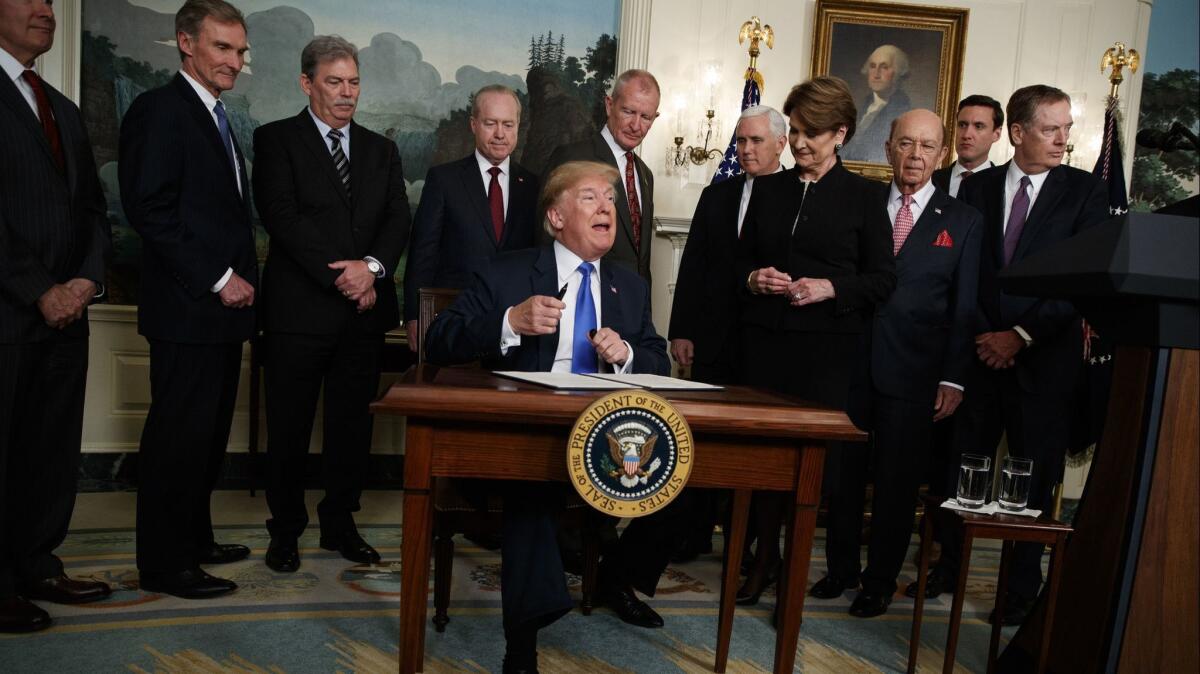Editorial: Trump ups the ante by $60 billion in his doomed trade war with China

- Share via
President Trump was evidently just warming up when he ordered global tariffs on steel, aluminum, solar panels and washing machines in recent weeks. The main event came Thursday, when the president announced plans to impose up to $60 billion in tariffs on China. This time, the president is focused on the right problems: China’s abuse of U.S. companies that do business there, its pursuit of technology developed here, and its support for hackers who steal trade secrets online.
Unfortunately, Trump is once again offering the wrong solution. The tariffs aren’t likely to inflict as much pain on China as they will on U.S. consumers and exporters.
For Trump, China has long represented the worst of the worst among trade cheats. The tariffs announced in previous weeks applied to metals and products from a vast array of countries, but their primary target was Chinese exporters that allegedly sell their goods below cost in defiance of global trade agreements. In the view of top administration officials, those unfair practices have been enormously costly to U.S. companies, causing factories to shut down and thousands of workers to lose their jobs.
It’s hard to see how slapping tariffs on as-yet-identified products will induce China to honor intellectual property rights.
But that’s only part of the story. Even if you accept the administration’s analysis, it is also true that cheap Chinese materials and assembly factories have helped U.S. companies compete and expand globally (see, e.g., Apple). In fact, one study estimates that the tariffs on steel and aluminum would create about 33,000 jobs at metals factories while costing nearly 180,000 in other industries.
Trump’s latest initiative focuses not on Chinese products, but on Chinese behavior — its cavalier attitude toward intellectual property rights and the hostile environment it has created for U.S. companies seeking to operate or invest in China. And on these points, there is widespread agreement that China has not only behaved badly, it has resisted years of pressure from U.S. leaders to change.
Among other things, China continues to require U.S. businesses to create joint ventures with Chinese firms in order to invest in selected industries, and in the process they often are forced to transfer valuable and novel technology to their Chinese partners. China also puts its thumb on the scales in negotiations between U.S. and Chinese firms, helping Chinese companies obtain U.S. technology on favorable terms.
China’s bad trade practices were damaging enough when the country was mainly a source of cheap consumer goods. But now that China’s industrial policy is focused on dominating such crucial 21st century fields as health sciences, artificial intelligence and aerospace, the stakes are considerably higher.
That’s why Trump’s tough talk and actions are drawing plaudits from some lawmakers in both parties, whose patience with China has understandably grown thin. And two pieces of Trump’s latest order — imposing restrictions on Chinese investments in the U.S. to match the ones China imposes on U.S. companies, and asking the World Trade Organization to rule against China’s “discriminatory licensing practices” — are welcome steps that respect the WTO and international trade agreements that the U.S. has pushed the world to embrace.
On the other hand, it’s hard to see how slapping tariffs on as-yet-identified products will induce China to honor intellectual property rights, permit more investment by U.S. firms or stop trying to steal trade secrets online. The tariffs will no doubt raise the price that U.S. consumers pay for those products. And they will just as surely prompt China to retaliate against U.S. exports, even as it finds new buyers for its own goods. That’s been the result when the U.S. has unilaterally imposed tariffs in the past, and there’s no reason to think the outcome would be any different this time.
The right steps to take are the ones that Trump has disdained since the day he took office. The industry groups and countries that have succeeded in changing China’s trade practices have been the ones that have acted in broad coalitions. Governments around the globe have complained about Chinese violations; the Trump administration should be organizing trading blocs to jointly demand changes from the Chinese through globally recognized institutions like the WTO that exist for just that purpose, backed up with tariffs and other sanctions if they don’t deliver.
Instead, the administration has gone in the exact opposite direction, bullying trade partners, threatening to cancel major free-trade deals and undermining the WTO. One of Trump’s first acts as president, in fact, was to pull the U.S. out of the Trans-Pacific Partnership — a 12-nation pact the U.S. had organized to counterbalance China’s influence in Asia and establish high standards for intellectual property protection, state-owned industries and other trade norms.
By calling out China’s mistreatment of foreign investors and competitors, Trump has echoed the sentiments of government leaders around the world. If only he’d lined them up — any of them — to help make his sanctions work.
Follow the Opinion section on Twitter @latimesopinion and Facebook
More to Read
A cure for the common opinion
Get thought-provoking perspectives with our weekly newsletter.
You may occasionally receive promotional content from the Los Angeles Times.









